|
Engineered specifically for 2018 Jeep Wrangler JL 3.6L V6 models, the K&N 71-1576 air intake system provides a guaranteed increase in horsepower and torque of approximately 9.1-horsepower and 10.4 lb.-ft*. The 71-1576 (part of the Blackhawk Induction™ series) includes a non-oiled synthetic DRYFLOW® filter, a black powder-coated aluminum intake tube, and steel heat shield, offering a guaranteed increase in horsepower and exceptional engine protection from contaminants.
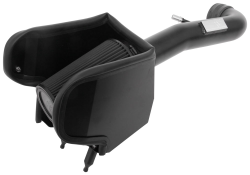
The 71-1576 includes a non-oiled synthetic DRYFLOW® filter
|
K&N PERFORMANCE AIR INTAKE SYSTEMS BOOST HORSEPOWER
If you want to give your Jeep industry-leading engine protection and an increase in power, check out the 71-1576 performance air intake system—specifically designed to fit in the engine bay of 2018 3.6L V6 Jeep Wranglers.
The 71-1576 system is designed to help keep engine air cooler (which can increase engine combustion efficiency), and provide a smooth, low-restriction path for airflow to the engine. Many stock intake systems have airflow-obstructing components that can create turbulence—and heat as a result—making engine combustion less efficient. By replacing the complete factory system with an aerodynamic tube and low-restriction filter, your engine will have access to a higher volume of cool air—giving you a guaranteed increase in horsepower and torque.
“Very easy to install; takes about an hour. definitely noticed a power improvement when towing my trailer. Well worth the money.” – Paul from Pennsylvania [Part No. 69-5321TS]
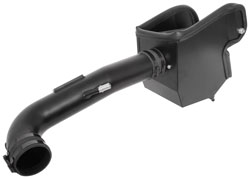
The 71-1576 features a powder-coated black aluminum intake tube
|
AERODYNAMIC INTAKE TUBE INCREASES AIRFLOW
Typical factory air intake systems force air through a restrictive disposable paper air filter before the air travels through a complex system of tubing—which often has tight bends, baffles, and other elements that can cause swirling, turbulent air. Excess turbulence can cause the molecules within the air to collide, which creates heat—and an increase in temperature reduces the density of oxygen molecules in the air. Since engine combustion is most efficient in an oxygen-rich environment, keeping engine air cooler often significantly increases engine combustion efficiency.
The 71-1576 intake system features a powder-coated mandrel-bent aluminum intake tube, which is engineered to reduce turbulence in the air and help keep engine air cooler—and increase engine performance! A steel heat shield also helps protect the air filter and intake air from high engine temperatures.
“Right away I felt the difference. It’s something that can’t be explained in words—you MUST buy one to know what I’m talk about. I’m looking forward to buying one for my other truck. THANK YOU K&N.” – Jonathan from California [Part No. 77-3050KP]
DRYFLOW® FILTER PROTECTS WITH NO OIL REQUIRED
The 71-1576 intake system—part of the Blackhawk Induction™ line—includes a DRYFLOW® synthetic air filter which never requires oiling. The DRYFLOW® filter media is composed of lofted synthetic material, which—much like High-Flow Air Filter™ media—provides depth loading properties. Each filter is designed to strike a desirable balance between airflow and efficiency, provide a high level of contaminant capture, and outperform typical disposable paper air filters in airflow. Because they do not have to be re-oiled, servicing DRYFLOW® air filters is typically a quick and easy process. Even better—you get a blacked-out, stylish appearance in your engine bay.
“Great buy. Before I got it I was skeptical about it. It makes the truck a little faster and definitely improves the sound when you get into the throttle. Would definitely recommend this product to anyone.” – Derek from Michigan [Part No. 77-3082KP]
|
INSTALLATION
The K&N 71-1576 intake system is engineered to incorporate factory mounting points and the factory mass air sensor. Installation can typically be completed in 90 minutes or less, and requires only simple hand tools. Detailed instructions are included in your kit, and installation videos for many vehicles are available on the K&N website.
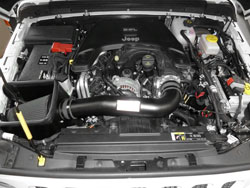
The 71-1576 after installation
|
Engineered to fit:
• 2018 Jeep Wrangler 3.6L V6 Fuel Injection All Models
“Easy to install. Very clear step by step directions provided.” – Mike from California [Part No. 57-2530]
WARRANTY
Each intake system comes with a 10-Year/Million Mile Limited Warranty. Furthermore, using a K&N replacement air intake system will not void your factory warranty; in the U.S., manufacturers must provide evidence that an aftermarket part is the cause of a necessary repair in order to void or deny warranty coverage. The Consumer Products Warranty Act of 1975 (also known as the Magnuson-Moss Warranty Act) protects consumers’ rights to their warranty coverage.
“I absolutely love this product. Did not take too long to install and the performance was noticeable. Highly recommended and I will tell all my friends about it.” – Richard from California [Part No. 71-3070]
DYNAMOMETER RESULTS
K&N performance air intake systems are protected by a guarantee—you will get an increase in horsepower and torque.
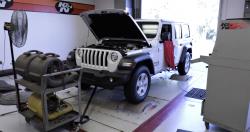
Every intake system is tested on the dynamometer for horsepower
|
During dynamometer testing, a 2018 Jeep Wrangler 3.6L V6 with a factory air intake system was recorded at 205.6-hp at 5,400 RPM. After installation of 71-1576, the same vehicle was recorded at 214.7-hp at 5,400 RPM—an estimated increase of 9.1-horsepower. The torque also jumped from 201.8 lb.-ft. to 212.2 lb.-ft.—an estimated increase of 10.4 lb.-ft at 3,000 RPM.
Horsepower gains vary among products and applications, but each K&N performance air intake system is designed to increase airflow efficiency for specific vehicles and their engines. Each kit undergoes significant testing to help ensure that the filter and intake tube are engineered to deliver large increases in airflow and horsepower. Please visit individual product pages to view horsepower estimates for your specific vehicle.
Visit this page to purchase the 71-1576 intake system, or visit the application search to explore other performance product options for your vehicle. Join the millions of customers who trust K&N to help them boost performance and protection in their vehicles!
*Estimated horsepower and torque gains based on specific or similar vehicle dynamometer tests. Results will vary. For more information, look up vehicle and/or testing protocols at knfilters.com.
|
Engineered specifically for 2017-2018 Nissan Titan XD 5.6L V8 models, the K&N® 63-6020 air intake system provides a guaranteed increase in horsepower and torque—and features a washable, reusable High-Flow Air Filter™ to help protect against damaging engine contaminants.
K&N PERFORMANCE AIR INTAKE SYSTEMS BOOST HORSEPOWER
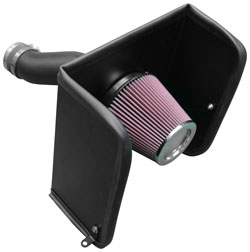
The 63-6020 features a High-Flow Air Filter with heat shield
|
If you want to give your Titan XD more power, check out the 63-6020 performance air intake system—specifically designed to fit in the engine bay of 2017-2018 3.2L V6 Titan XDs. The 63-6020 is designed to help keep engine air cooler (which can increase engine combustion efficiency), and provides a smooth, low-restriction path for airflow to the engine. Many stock intake systems have airflow-obstructing components that can create turbulence—and thus heat—resulting in less efficient combustion, and giving you less horsepower. By replacing the complete factory system with an aerodynamic tube and High-Flow Air Filter™, your engine will have access to a higher volume of cool air—giving you a guaranteed increase in horsepower and torque.
“Easy install, smoothed out the whole system. Instructions were clear and relatively simple. I had previously installed a new cat-back pipe and wasn't completely sold on the sound...the K&N intake helped the engine breathe and actually gave me a rich, deep, smooth tone from the pipes. Noticeable increase in response as well.” – Preston from Wilmington, Delaware [Part No. 63-9039]
AERODYNAMIC INTAKE TUBE INCREASES AIRFLOW
Typical factory air intake systems force air through a restrictive disposable paper air filter before the air travels through a complex system of tubing—which often has tight bends, baffles, and other elements that can cause swirling, turbulent air. Excess turbulence can cause the molecules within the air to collide, which creates heat—and an increase in temperature reduces the density of oxygen molecules in the air. Since engine combustion is most efficient in an oxygen-rich environment, keeping engine air cooler often significantly increases engine combustion efficiency.
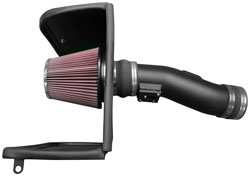
An aerodynamic intake tube helps accelerate airflow
|
The 63-6020 intake system features a free-flowing, high-density polyethylene intake tube, which is engineered to reduce turbulence in the air, keeping engine air cooler—and increasing engine performance! The 63-6020 also incorporates a steel heat shield, which helps protect the air filter and intake air from high engine temperatures.
“Amazing product, sounds great and would recommend to anyone. Very prominent when accelerating and in the higher rev range. This is my first K&N product and would definitely buy from them again.” – Zachary from Bristol, UK [Part No. 69-6000TP]
HIGH-FLOW AIR FILTER™ OFFERS EXCEPTIONAL PROTECTION
Most factory disposable paper filters only “surface load” contaminants—collecting them on the surface of the media, which over time can reduce the filter’s efficiency due to clogging. Alternatively, High-Flow Air Filters™ “depth load” contaminants; multiple layers of cotton fibers capture particles on many levels. Because the contaminants are incorporated into the filter fibers, the filter can still operate without significantly reducing its performance.
The High-Flow Air Filter™ included in the 63-6020 intake kit is oversized with a conical shape, providing a greater surface area and allowing for a service interval of up to 100,000 miles between cleanings (under normal highway driving conditions). High-Flow Air Filters feature an oiled, layered design. When your filter does need to be cleaned, you can use the K&N Recharger® Kit (99-5000 or 99-5050) to quickly and easily restore your filter’s performance. Each K&N intake (and filter!) is designed to last for the life of your vehicle.
“Great product. Easy to install. And wow what a performance improvement.” – Marcus from Raleigh [Part No. 71-4519]
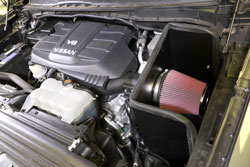
The 63-6020 intake system after installation
|
INSTALLATION
The K&N 63-6020 intake system is engineered to incorporate factory mounting points and the factory mass air sensor. Installation can typically be completed in 90 minutes or less, and requires only simple hand tools. Detailed instructions are included in your kit, and installation videos for many vehicles are available on the K&N website.
Engineered to fit:
• 2017 Nissan Titan XD 5.6L V8 Fuel Injection All Models
• 2018 Nissan Titan XD 5.6L V8 Fuel Injection All Models
WARRANTY
Each intake system comes with a 10-Year/Million Mile Limited Warranty. Furthermore, using a K&N replacement air intake system will not void your factory warranty; in the U.S., manufacturers must provide evidence that an aftermarket part is the cause of a necessary repair in order to void or deny warranty coverage. The Consumer Products Warranty Act of 1975 (also known as the Magnuson-Moss Warranty Act) protects consumers’ rights to their warranty coverage.
“Couldn’t be happier with this intake. Easy installation, great sound and noticable performance. Looks great, sounds great and performs as advertised. Well done K&N.” – Shawn from Raleigh, NC [Part No. 69-8621TTK]
|
DYNAMOMETER RESULTS
K&N performance air intake systems come with a horsepower guarantee—you will get an increase in horsepower and torque! During dynamometer testing, a stock 2018 Nissan Titan XD 5.6L with a factory air intake system was recorded at 317.1-horsepower at 5,502 RPM. After installation of 63-6020, the same vehicle was recorded at 327.0-horsepower at 5,502 RPM—an estimated increase of 9.9-horsepower. The torque also jumped from 250.5 lb.-ft. to 267.2 lb.-ft.—an estimated increase of 16.7 lb.-ft. at 3,024 RPM.
Horsepower gains vary among products and applications, but each K&N performance air intake system is designed to increase airflow efficiency for specific vehicles and their engines. Each kit undergoes significant testing to help ensure that the filter and intake tube are engineered to deliver large increases in airflow and horsepower. Please visit individual product pages to view horsepower estimates for your specific vehicle.
“Everything that was needed was included in the box. The install was easy, under one hour. It took longer to put the air box together. The engine sounds great and pick up has improved. I am very satisfied with this system. It does make a big difference in driving and puts a big smile on your face.” – G MAN from Mesa, AZ [Part No. 63-1561]
INTAKE SYSTEM OPTIONS
For many vehicle applications, multiple options of K&N intake systems are available. 69-Series and 77-Series intakes feature mandrel-bent aluminum intake tubes, while 57-Series and 63-Series intakes have high-density polyethylene intake tubes. 71-Series intakes are from the Blackhawk Induction™ line, which feature a black powder-coated aluminum intake tube and a black oil-free synthetic filter. Please view the specific product pages for details on each intake type.
Visit this page to purchase the 63-6020 air intake system, or visit the vehicle search page to explore air intake system options for your vehicle. Join the millions of customers who trust K&N to help them boost performance and protection in their vehicles!
|
Engineered specifically to fit the engine bay of 2017-2018 Honda Civic Type R models, the K&N® 69-1505TWR air intake system provides a guaranteed increase in horsepower and torque (an estimated 12.6 horsepower from dynamometer testing). The 69-1505TWR system features a washable, reusable High-Flow Air Filter™, a low-restriction aluminum intake tube, and a custom steel heat shield. The unique heat shield design incorporates the vehicle’s hood in order to simulate a closed air box—keeping your engine air cooler, and giving you an increase in performance!
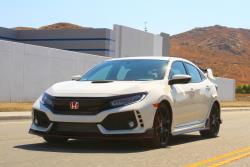
The 2018 Honda Civic Type R
|
K&N PERFORMANCE AIR INTAKE SYSTEMS BOOST HORSEPOWER
If you want to give your Type R top-quality engine protection and a guaranteed increase in horsepower, check out the 69-1505TWR performance air intake system—specifically designed to fit in the engine bay of 2017-2018 Honda Type Rs. A low-restriction tube allows airflow to move through the system efficiently, and helps prevent turbulent air (and heat). An innovative heat shield design helps provide outstanding protection against high temperatures. Giving your engine a higher volume of cooler air an increase its combustion efficiency, which translates to greater horsepower for your vehicle!
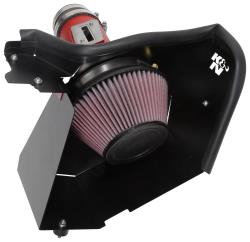
A unique heat shield design helps protect against high temperatures
|
HIGH-FLOW AIR FILTER™ DESIGNED FOR OUTSTANDING PROTECTION
Most factory disposable paper filters only “surface load” contaminants—collecting them on the surface of the media, which over time can reduce the filter’s efficiency due to clogging. Alternatively, High-Flow Air Filters™ “depth load” contaminants; multiple layers of cotton fibers capture particles on many levels. Because the contaminants are incorporated into the filter fibers, the filter can still operate without significantly reducing its performance.
The High-Flow Air Filter™ included in the 69-1505TWR intake kit is oversized with a conical shape, providing a greater surface area and allowing for a service interval of up to 100,000 miles between cleanings (under normal highway driving conditions). High-Flow Air Filters feature an oiled, layered design. When your filter does need to be cleaned, you can use the K&N Recharger® Kit (99-5000 or 99-5050) to quickly and easily restore your filter’s performance. Each K&N intake (and filter!) is designed to last for the life of your vehicle.
INSTALLATION
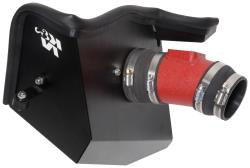
An aerodynamic intake tube helps increase airflow
|
The K&N 69-1505TWR intake system is engineered to incorporate factory mounting points and the factory mass air sensor. Installation can typically be completed in 90 minutes or less, and requires only simple hand tools. Detailed instructions are included in your kit, and installation videos for many vehicles are available on the K&N website.
Engineered to fit:
2018 Honda Civic Type R 2.0L L4 Fuel Injection: All Models
2017 Honda Civic Type R 2.0L L4 Fuel Injection: All Models
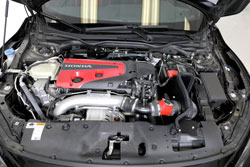
The 69-1505TWR after installation
|
WARRANTY
Each intake system comes with a 10-Year/Million Mile Limited Warranty. Furthermore, using a K&N replacement air intake system will not void your factory warranty; in the U.S., manufacturers must provide evidence that an aftermarket part is the cause of a necessary repair in order to void or deny warranty coverage. The Consumer Products Warranty Act of 1975 (also known as the Magnuson-Moss Warranty Act) protects consumers’ rights to their warranty coverage.
DYNAMOMETER RESULTS
When buying a K&N performance air intake system, you’re protected by the guarantee that you’ll gain horsepower and torque after installation!
During dynamometer testing, a 2017 Honda Civic Type R with a factory air intake system was recorded at 292.4-hp at 6,122 RPM. After installation of 69-1505TWR, the same vehicle was recorded at 305.0-hp at 6,122 RPM—an estimated increase of 12.6-horsepower. The torque also increased from 254.6 lb.-ft. to 274.0 lb.-ft.—an estimated increase of 19.4 lb.-ft. at 3,731 RPM.
Visit this page to purchase the 69-1505TWR air intake system, or visit this link to explore other performance product options for your vehicle. Join the millions of customers who trust K&N to help them boost performance and protection in their vehicles!
|
|
A comprehensive guide to evaluating prospective purchases
VEHICLES TO AVOID
• Law enforcement vehicles, fleet cars, rental vehicles, taxis, or vehicles that have been used for ride-share services: these should all be at the very bottom of your purchase list. Even if they appear to be in pretty good shape, they’ve most likely racked up an excessive amount of mileage—and were almost certainly operated under fairly harsh driving conditions.
• Lemons: vehicles that have warranty-covered defects which cannot be repaired by the manufacturer within a certain time period, and after several attempts, are considered lemons in most states (though the requirements vary). Depending on location, if a manufacturer re-purchases a defective vehicle, the title must reflect that it is a lemon law buyback. Purchasing these cars is generally not advisable, since the manufacturer will have already made several attempts to rectify the problem before re-purchasing it from the owner.
• Salvaged: salvaged vehicles have been damaged to the degree that the insurance company, leasing company, or owner has decided it isn’t worth the cost of repairs. If the damage is very minimal (which is unlikely, considering that the car is most likely worth less than the cost of repairing it), you could consider purchasing—but keep in mind that if the car has been in an accident, it could have sustained more serious damage than meets the eye (which leads us into the next category)—
• Wrecked and repaired: if a car has been in a wreck, it may have sustained frame damage that could cause instability and issues in the future. If you’re interested in purchasing a vehicle that has been involved in a wreck, be sure to request the repair invoices/records to see what type of work has been completed.
• Storm registry: some vehicles that have sustained flood damage are moved great distances in order to be sold in other areas where buyers might not be as well-versed in inspecting for water damage. The National Motor Vehicle Title Information System (NMVTIS) can help you research the background of your prospective new vehicle to make sure that the title isn’t missing any important information (but it’s still important to check for signs of water damage even if the title comes up clear).

You’re ready to lay down some hard-earned cash—so take the time to evaluate your purchase.
|
• Potentially stolen: if you have any suspicions that the used vehicle you’re interested in may have been stolen (some clues include if the VIN plate is missing/repainted, the VIN on the title doesn’t agree with the one on the body, or the vehicle is priced lower than its value), it’s best to just walk away.
EVALUATING THE EXTERIOR
Arriving with a checklist can let prospective sellers know that you’re serious about fully evaluating the vehicle—and can help you reduce the buying price if you locate areas that need repair.
• Take a 360° view of the car
Circle the car and try to look from every angle. Are there any ripples in the body that might indicate damage? Is the paintjob in good shape? Look carefully along the body at an angle—instead of straight on—to see if you can catch any dings or paint cover-ups in the reflection.
• Look for dents and paint abnormalities
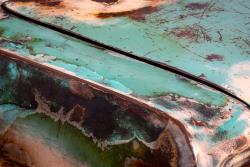
Corrosion is serious—and it will only get worse.
|
Severe dents and chipped paint can be expensive repairs. If the seller hasn’t already discounted the price to account for the damage, make sure the proper deductions are made. If you notice areas that have been re-painted, it should tip you off that the vehicle may have been in an accident.
• Keep a sharp eye out for rust
Rust spreads—which is why it should always be immediately removed/repaired when noticed. Even if it is painted over, which some unscrupulous sellers will do, the surface beneath will continue to degrade. Don’t forget to look for rust on the underside of the car, in the wheel wells, and under the trunk mats. If you observe anything other than very mild rusting, it’s best to walk away.
• Check for salt corrosion on the undercarriage
Salted roads can accelerate corrosion on the undercarriage of a vehicle, so bring a flashlight and make sure to get down on your hands and knees. If the vehicle has a brand-new undercoating, that may be a red flag that the seller is trying to hide corrosion.
• Look for signs of a bent frame
Spot welds and bent frames are signs of wreck repairs, and should be an immediate deal-breaker if not already disclosed by the seller.
• Check to make sure the doors, hood, and trunk all latch firmly
If a vehicle has been in an accident, door latches, hood latches, and trunk latches may be thrown out of alignment. This is also a good time to check the insides of doors and in the trunk for signs of repainting.
• Watch for sagging
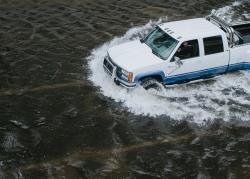
Always look for signs of water damage in any prospective used vehicle.
|
The front and rear of the vehicle should be level when resting on a flat surface. If you see unevenness either front-to-back or left-to-right, it could be an indication that the suspension is damaged.
• Look for tell-tale signs of water damage
If a car has been flooded out, you will typically be able to find water stains inside the trunk, under the seats, and under carpeting—and the car may have a musty smell.
• Check for leaks
Move the vehicle from where it was parked, and check to see if there are any fresh leak spots.
• Inspect the tires
Tires should all be the same size and type; unmatched/unbalanced tires can negatively affect gas mileage and potentially cause premature wear. Look carefully at the treads—wear on the outside treads can indicate an alignment issue. Correcting front-end alignment is usually relatively inexpensive, but rear-end alignment issues could indicate a bent rear axle, which is an expensive repair.

Make sure the condition of the interior approximately matches the number on the odometer.
|
|
EVALUATING THE INTERIOR
• Take a look at the carpet and upholstery
A pristine interior may or may not be important to you, but evaluate whether or not the interior wear matches up with the mileage number you’ve been given. If the steering wheel or other interior components are extremely worn, the odometer shouldn’t read at only 30,000 miles.
• Try all of the seat belts
Make sure you can find all of the back-seat belts, and that they are all operational.
• Look for airbag powder

Check all of the seat belts to make sure they’re operational.
|
If the vehicle has been in an accident that caused the airbags to deploy, you may be able to see trace residue of the airbag powder inside the interior. Check in places that are more difficult to clean—like under and between seats, under floormats, and around the steering column.
• Try all the door locks and window controls
Repairing these will require you to disassemble the door, which can be time consuming and potentially expensive.
• Check the odometer
If the number seems too good to be true, it probably is. It’s possible to tamper with odometers, which is why it’s critically important to examine all of a car’s official records (and service providers often note the mileage on invoices, assuming you are given previous service records to peruse).
• Check all the lights (with help from a friend)
Have someone stand outside the vehicle and see if the headlights, front and rear signals, fog lights, and high beams are all operational. This is also a good time to have a friend check to see if any smoke comes from the tailpipe while the engine is running.
• Check windshield wipers, the sound system, the heater, A/C and heat, and interior lights
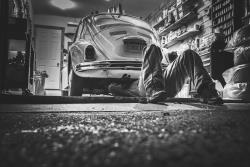
It’s never a bad idea to have a trusted mechanic evaluate your prospective purchase.
|
Give all the controls a go, just to make sure you don’t have any surprises once the weather changes.
UNDER THE HOOD
• Take a look at the radiator and hoses
Cracked and brittle hoses indicate the need for replacement.
• Check the radiator fluid level/color
The fluid should be near the full line. If it’s clear, it is likely water—which is not a good sign that the car has been properly maintained. If you see oil floating on the surface of the fluid, a cylinder has likely cracked, and you’ll likely want to walk away from the purchase.
• Check the wiring
Can you see anything loose, cracked, or frayed?
• Check the fan belts
Frayed, cracked, or brittle belts should be replaced.
• Check the spark plug cables
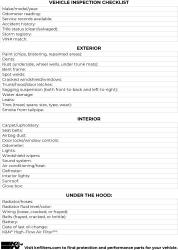
Print this complementary vehicle evaluation checklist
|
This isn’t an extremely expensive repair, but cracked or brittle spark plug wires can potentially cause the engine to misfire.
• Inspect the battery
Corroded terminals indicate the need for a new battery. The seller may attempt to clean the battery before a sale, so check the battery cables too.
• Ask when the oil filters, air filters, and fuel filters were last replaced
Records of regular maintenance are a definite plus. If the car has a stock air filter, consider switching it out for a K&N High-Flow Air Filter™, which is washable, reusable, and designed to last for the lifespan of your vehicle.
ROUND-UP
Before purchasing any used vehicle, it’s important to do a thorough inspection—and if possible, hire a trusted mechanic to do the inspection with you. Make sure to do a test drive (with the windows rolled down, and also up!) and listen for any strange noises or rattles. Check the brakes for screeching, and note whether the transmission moves smoothly between gears. If you do end up purchasing a used vehicle, make sure to invest in any necessary maintenance. We recommend immediately replacing your disposable air filter with a K&N® High-Flow Air Filter™, which provides your vehicle with exceptional engine protection and airflow. Feel free to print the complementary vehicle inspection checklist included above to help with your next used car purchase.
Explore all of the products that K&N® has for your vehicle here, and join the millions of vehicle enthusiasts who trust K&N® to provide performance, protection, longevity, and clean air!
| |



























